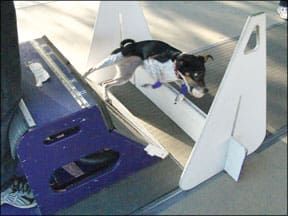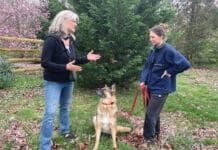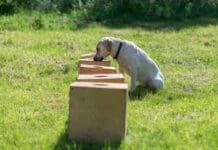READY? R-E-A-D-Y? GO!
Woof, yap, scream, yodel, bark, yip. Go, go, go!” Dogs on the sidelines and in crates and exercise pens barking at the top of their lungs. Dogs tugging and growling, tugging and growling. Handlers yelling over the din to their teammates. Handlers recalling their dogs over jumps, H-e-r-e! Event officials blowing whistles and announcing the next race over bullhorns or speaker systems, and start-line lights and passing lights flashing on and off.

Todd Minella
288
Flyball is a cacophony of sights and sounds. It is exhilarating, over the top, adrenalized hyperstimulation. This is not a sport for the introverted, timid, or sound-sensitive dog or handler. The adrenalin level is off the charts and you can hear that from hundreds of yards away.
The first time I experienced flyball was as a spectator at an obedience trial held at a park. Suddenly, shattering the decorum, was an ear-piercing scream followed by rabid barking. Certain that an obedience dog had left the ring and treed a critter, I raced over to watch. No critter. No mayhem. Just flyball. The teams had just set up for their first race and the dogs were ready. I had never seen dogs so keen to get going.
The game
There are four hurdles in a row with the flyball box at the end of the 51-foot lane. The jump height for each team is determined by the height of the shortest dog on the team. These dogs are referred to as the “height dog”. Each team tries to attract someone with a fast, short dog so their team has the advantage of low jump heights. That’s why it’s common to see teams with very short dogs as well as larger dogs.
Each team has four dogs. Two teams race at the same time, 20 feet away from each other. Each team lines up their dogs, ready to release them quickly, exactly when the previous dog clears the last jump. Dogs are taught to pass each other very close to gain a time advantage.
Each handler restrains her dog at the start line, careful not to cause a false start by letting go too early. The typical flyball start-line restraint technique is to hold the dogs in front of their hind legs, crouching behind the dogs.
When the dog gets to the flyball box, he is trained to hit the box with his front feet, grab the ejected ball (most dogs just place their mouths over the opening where the ball comes out), push off the box with his rear legs, and race back.
A member of the team stands at the box to load balls (small dogs might need a small tennis ball) and encourage the dogs to get to the box fast (more screaming). The handler of the dog currently racing stands back, beyond the finish line, usually with a long tug toy, and encourages the dog to race back to the handler, quickly, over the finish line (with more screaming!).
History
In the late 1960s and early f70s a group of trainers in Southern California created a game that required their dogs to jump over some hurdles and pick out a dumbbell with their handler’s scent. They called it scent hurdling. To reward the dogs for taking the hurdles, someone threw a tennis ball at the end of the straight row of hurdles.
Soon, scent hurdling morphed into flyball. The first flyball tournament, however, didn’t take place until 1983. Soon thereafter, 12 flyballs clubs from Michigan and Ontario, Canada, developed guidelines for the sport, and in 1984 the North American Flyball Association, Inc. (NAFA) was born. The first flyball rule book was written in 1985 by Mike Randall, then executive director of NAFA.

288
In 2002, the United Flyball League International (U-FLI) was founded. NAFA and U-FLI are currently the only two organizations that sanction tournaments. Their rules and philosophies differ somewhat, but all breeds and mixes are welcome.
The popularity of the sport has grown over the years, with tournaments taking place in North America, Europe, Australia, and other countries. The NAFA website claims 700 registered clubs and more than 16,000 registered dogs.
Attributes of a flyball dog
Flyball is a strenuous, pressure-cooker game. Dogs are rewarded for intense bursts of activity. Racing down a row of jumps, slamming into the box that holds the ball, turning on a dime, and racing back down the row of jumps to their handlers against a backdrop of another teams’ dogs a mere 20 feet away requires a dog to be incredibly focused, physically resilient to the rigors of training, and insane about the tennis ball.
The repetitive nature of some of the training is physically demanding, and a dog must have the temperament to withstand the performance stressors inherent in the game. These include barking and lunging dogs, screaming people, and intense performance pressure from his handler.
Nikki Myers, CPDT, who in 1995 cofounded Woof Gang, a Southern California flyball team, has been competing and training in the sport for 14 years. Her now 16-year-old Silky Terrier is still ranked as the #1 Silky in NAFA, and her newest Silky, Charm, is currently the fastest Silky in flyball. Her Australian terrier, Maggie, is ranked second for her breed in both U-FLI and NAFA. Myers is familiar with many of the dog sports, competing in agility for 15 years and in earthdog for 10 years, and has been a professional dog trainer for the past 9 years. Myers notes that owners should assess the physical, as well as the behavioral, demands of a sport before deciding whether it is appropriate for their dogs.
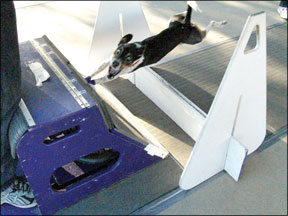
Sally Frankel
288
“The physical demands on a flyball dog are quite high. Running-jumping-stopping-turning-running can be hard on a body. Larger dogs need to build the muscle to control their added kinetic energy to be able to stop themselves safely. Extra weight on any size dog can increase the chance of injury. Joints get a lot of punishment, so hip and elbow dysplasia or patella luxation, etc., will affect a dogfs performance. As with any sport, a dog should be cleared by his vet if he hasn’t had a very active life so far. A couch potato at five years of age may have some aches and pains if they suddenly start a new sport,” says Myers.
The variety of mixes and breeds that participate in flyball is a testament to the draw of this sport for a broad cross section of dogs. Everything from Airedales and American Bulldogs to the typical slew of herding breeds and terriers are in evidence. There are Chinese Cresteds, Danish/Swedish Farmdogs, Deerhounds, Irish Red and White Setters, a Plott Hound, and even a Black Mouth Cur listed on U-FLI’s website (see u-fli.com/dogbreedreport.php for the complete report).
If you have a high-energy, outgoing, confident dog who loves to retrieve balls, this might be his sport. If your dog is a bit reserved, the sport could help him build more confidence. However, according to Myers, “Flyball can help a shy dog get some confidence, but if the dog is truly fearful of new places, noises, etc., he should learn flyball only as a backyard activity. The dogs who do best in flyball are those with a very high drive. The perpetual-motion kind of dog that can focus on the task of flyball will do very well.”
Handler attributes
In addition to the commitment to training and attending team practices, handlers exert a fair amount of physical effort participating in this sport. In addition to helping set up equipment for practices and lugging all your personal training supplies and dog from your car to the field, flyball can be physically strenuous.
“The physical demands on the handler are varied,” explains Myers. A certain amount of bending and squatting are encountered. After a long weekend of racing, I feel like I’ve done a hundred lunges. My thighs burn and my back aches. Once your dog is really worked up about racing, he also tends to pull hard on the leash around the grounds. (It can be hard to maintain your loose-leash walking criterion!)
“There is also a certain amount of running for the handlers. Think of wind sprints and you’ll get the idea. It really depends on the dog you are running. I run and tug and spend a lot more energy running a Boston Terrier than I do handling a teammate’s Australian Shepherd.”
Equipment and supplies
The equipment needed to practice flyball is not extensive, but it can be expensive, due to one specialized item (the flyball box).
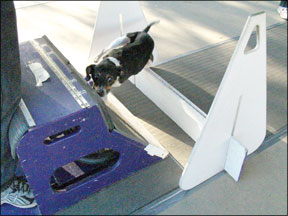
Sally Frankel
288
•Hurdles. There are four hurdles, or jumps. These are relatively light-weight, narrow panel jumps. They can be made by handy team members with a Skill saw and white paint or ordered ready-made. Hurdles are pretty inexpensive compared to the box.
•The box. The spring-loaded box that ejects the tennis ball is the major expense for a flyball team. Specifications are set by the sanctioning organization. Many clubs make their own, but the boxes are available for purchase. Plan on spending at least $600 and as much as $1,200.
•Tennis balls and tug toys. Standard-size tennis balls are used in great quantity so it helps to know someone who belongs to a tennis club. Small tennis balls are used for the small dogs and can be purchased from pet stores and online. Lengthy tug toys, usually about 24 to 36 inches long, are used to incite the dog to run back to the handler with the tennis ball. Often, a tennis ball has been woven into the tug toy, as well.
Expenses
In addition to the costs of supplies listed above, there are other expenses. If you can find a public class such as the one Myers offers through a city entity, costs are modest and, in most cases, move you quickly toward joining a team where members practice together at no cost.
There are also modest team dues, and members share in the purchase and repair of equipment. Tournament entry fees are split by the team members and vary throughout the country, but average about $90. The cost of travel and lodging is often a flyball handler’s biggest expense. As with many different sports, it is the ancillary costs that mount. These include canopies to protect you and your dog from the elements, treats, toys, crates, blankets, and the list goes on.
Training
Myers, a professional trainer with years of experience teaching with positive reinforcement methods, teaches public classes for the city of Garden Grove, California. Those classes serve as a pipeline for new teammates for local flyball teams.
Although many teams are willing to train people and their dogs from the ground up, it helps if you and your dog have a general training history already established. Clicker training, which focuses on encouraging dogs to “offer” behaviors, can accelerate the training process because dogs learn to see training as a problem-solving game.
Myers simplifies the complexities of training flyball by breaking it down into separate behaviors and then “chaining” them together.
“Flyball is one long ‘behavior chain,’” explains Myers. “There are several links in the chain: run, jump, trigger the box, grab the ball, turn, run-jump-run (now with a ball in your mouth). We teach this chain in pieces. Running down the lane of jumps to have fun with Mama is one of the easiest to teach. Triggering the box to retrieve the ball safely and swiftly is the most difficult. Rarely do we need to teach a dog to retrieve a ball, though there are some dogs that need to learn a retrieve before they start with flyball.”
You can do some training at home that will benefit you and your dog whether you choose to join a team or not.
•Toy motivation. Tugging is a great motivator and helps focus your dog on you. If your dog is not toy-motivated, play games that get your dog chasing you for fun and reinforcement. Get a long tug toy and drag it along the ground and encourage your dog to “get it, get it, get it,” and make a big fuss over him when he expresses any interest in it. Gradually, reward only more and more interest in the toy until he is biting at it and then holding on to it.

Sally Frankel
288
•Restrained recalls. Flyball dogs must come when called in the face of huge distractions (the park, other dogs, high levels of arousal of other dogs and people, etc.). A speedy return to the handler over the finish line is essentially a recall. Start with one person holding your dog back while you run away, waving a toy. The person restraining your dog delays your dog’s release just a second or two at a time, waiting to feel the dog pulling to get away.
According to Myers, “When you can get your dog to stop barking at a squirrel in the backyard and run to you for a toy or play, you’ve a long way in ensuring a solid recall during competition.”
•Jumping. If you have space in your backyard, a line of jumps is a simple, inexpensive training tool. Encourage your dog to take the first jump and throw your toy ahead. Once your dog is confident and fast with one jump, add another one. Gradually, add others until you have four in a row.
Practicing at home is important, but flyball is essentially a team sport. If you are a loner and do not enjoy group dynamics, this may not be the best sport for you. Some teams practice an hour or two once a week, while others get together three to four times a week.
Myers notes, “Most of the competitors in flyball are members of a team. When a club enters its team in a particular tournament, the members train together and learn to compete together. When a change has to be made at the last minute, it can do anything from simply change the lineup to causing the team to drop from the competition.
”With the addition of the United Flyball League, however, the opportunity has increased for single dogs or just pairs of dogs to race.”
Levels of competition
Flyball dogs earn individual points in each tournament based on their dog’s racing times. Remember, each dog travels 51 feet over four hurdles, hits the box, grabs the ball, and races back over the hurdles across the finish line. This is considered one “heat” of a race, and there can be four to five races in a day. Since a race is made up of three to five heats, your dog may run that 102-foot lane 20 times or more in a day. Now you see why high-energy dogs do well in this sport.
NAFA and U-FLI award different points in their respective systems for each heat. For example, U-FLI awards 30 points to dogs who run that distance under 20 seconds, 25 points for under 25 seconds, 15 points for under 30, and 10 points for under 35. Your dog gets an additional 5 points if your team wins the tournament race. A dog running on a well-trained, consistent team could earn 75-125 points for each race. Multiply that times the number of races in a day and your dog can rack up quite a few points toward titles in a single tournament.
U-FLI titles are awarded based on your dog’s cumulative points. “Top flight” requires 100 points, “top flight executive” requires 2,500 points, and so on until the top U-FLI title of “top flight extreme” with 54,500 points.
Wondering how fast is fast? The NAFA record is 15.22 seconds and was set in 2005 by Spring Loaded, a team with members from Illinois, Michigan, and Ontario, Canada. The U-FLI record of 15.023 seconds was attained by Touch n Go, a team from Las Vegas, Nevada. This means that each dog ran the 102-foot distance in under four seconds. Wow!

Sally Frankel
288
Teams compete in “divisions”, which are established to ensure that teams compete against other teams of similar abilities. NAFA and U-FLI each have their rule books on their respective websites.
How to get started
If you want to compete, make sure you can commit to this team endeavor. Myers recommends, “Look for a local team that teaches. Start asking questions and going to tournaments. Teams want to see that you are interested in the commitment and not just out for the summer.”
If you want to try it out before committing, look for those public classes (which can be few and far between) and for a willing and qualified instructor. Myers has taught people who knew they wanted to compete, as well as those who were just looking for something to entertain their dogs.
”I had one couple who brought their two dogs. The dogs were not all that crazy about tennis balls, but they loved their stuffy toys. We ended up with the stuffy toy at the box instead of the balls. Both dogs learned to come down the lane, get the stuffed toy, and return over all four jumps. That couple really enjoyed their dogs’ version of flyball!”
”Another couple started out in the public class, and then started practicing with Woof Gang. Their shepherd-mix has been competing for a year now. Since then, they rescued another shepherd-mix and taught him to play as well. They recently bought an RV to take to tournaments, and both dogs will be competing together on teams very soon.”
Is this sport for you?
Since flyball is a team sport, whether this sport is for you or not may depend upon where you live. Some areas of the country have no teams and no competitions, while others have many. If this sport appeals to you, go to the websites listed in this article and see if there is a team near you. Contact them and find out when they practice and ask to come and watch. How do they treat the dogs? Are they positive with each other as well as with their dogs? How well do they support new people?
If you have a family that might want to get involved, check out U-FLI. They have a program specifically designed to encourage and support families with children. Find a team that competes in U-FLI and then check out how well that team emulates U-FLI’s philosophy.
Each team is a culture unto itself. Some are inviting of new people and others are not. Some are extremely competitive and put a lot of pressure on members to attend multiple practices and compete at every opportunity while others are happy to build the skills of all members and invite everyone to practice and compete regardless of skill level.
Because flyball is a team sport, the human dynamics of a particular team are critical in deciding which team to join. Many flyball handlers consider their flyball team like a second family. Unlike with your biological family, you have some choice in choosing this one.
As usual, have fun, train positively, and revel in the relationship with your dog, not the ribbons on the wall.
Terry Long, CPDT, is a writer, agility instructor, and behavior counselor in Long Beach, California. She is addicted to agility and animal behavior.


